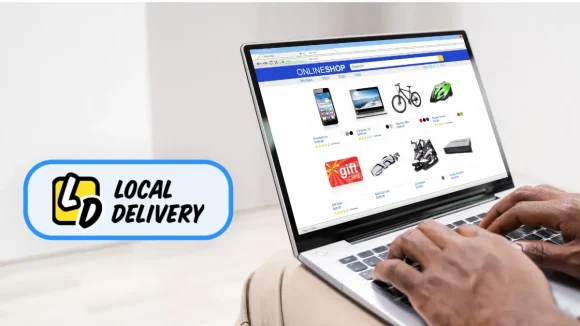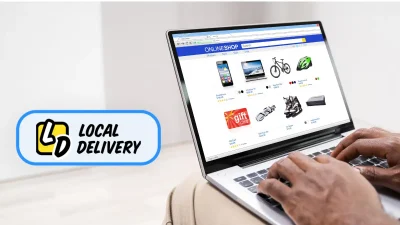Optimizing delivery logistics in the e-commerce era is crucial for businesses to thrive and meet the ever-growing customer demands. Timely demand fulfilment has become a top priority, requiring e-commerce businesses to streamline their delivery operations. To succeed in this competitive landscape, businesses must adopt efficient strategies and technologies to optimize their delivery logistics.
This article delves into the significance of optimizing delivery logistics in the e-commerce era and explores key approaches to ensure timely demand fulfillment, enhancing customer satisfaction and driving business growth.

Optimizing Delivery Logistics in the E-Commerce Era: Revamped Guidelines
How E-Commerce Affects Delivery Logistics
The rise of internet shopping and its impact on the need for deliveries
The e-commerce sector has grown rapidly in recent years, completely changing how people shop. More consumers are using online platforms to make purchases due to the simplicity of doing so. The need for deliveries has been significantly impacted by the rise in internet shopping.
The exponential growth of online shopping:
The rate at which online retail sales are growing is exponential. As e-commerce grows, statistics show a sharp rise in online retail sales. Online purchases are steadily increasing as a result of consumers’ growing attraction to the accessibility and convenience provided by online platforms.
Effect on delivery demand
As a result of the change to online shopping, the volume and frequency of deliveries have dramatically increased. Customers anticipate speedy, accurate, and convenient delivery of their orders. Delivery systems now face intense pressure to adjust to the escalating demand.
Issues with conventional delivery systems
In order to keep up with the changing demands of the e-commerce era, traditional delivery systems have had to overcome various obstacles.
Issues with scalability and capacity
Scalability and capacity issues
- The greater stocks needed to fill online purchases are frequently too much for traditional warehouse facilities to handle. Order fulfillment delays and inefficiencies can be caused by a lack of storage space and ineffective inventory management procedures.
Complexities of last-mile delivery
- The final mile of the delivery process poses special difficulties. Obstacles to prompt and effective deliveries are created by urban congestion, traffic, and a variety of consumer locations. It becomes more difficult to meet client demands for flexible delivery alternatives and time windows.
Pressures on costs and profitability
- As a result of the rising delivery volume, traditional delivery methods are experiencing greater operational costs. In a highly competitive e-commerce market, keeping competitive prices while ensuring profitability can be challenging.
The requirement for revised regulations to reflect new requirements
- In order to successfully manage the challenges brought on by the e-commerce era, revised regulations that are in line with the changing delivery logistics environment are absolutely necessary.
Adapting to the changing environment
- Conventional delivery methods frequently lack the capacity to meet the needs of the quickly expanding e-commerce sector. Given this, it is obvious that creative and effective solutions are needed to meet the increased criteria.
Delivering on client expectations
- Customers demand delivery services that are quick, dependable, and transparent. They look for flexible delivery alternatives and simple return procedures. To increase satisfaction, revised policies should strive to satisfy these raised customer expectations.
Increasing operational effectiveness
- Current best practices and recommendations can simplify the delivery process, increasing effectiveness and lowering costs. Adopting tech-driven solutions can greatly enhance logistics operations overall. Examples include sophisticated route planning, real-time tracking, and automated inventory management.
Collaboration and industry standards
- For thorough delivery guidelines to be developed, industry players must work together. By establishing industry-wide standards, different e-commerce platforms and delivery services are guaranteed to provide uniform service quality and consumer satisfaction.

Important Elements Affecting Redesigned Delivery Logistics
Delivery that is quick and effective
- Speed and efficiency in delivery play a critical part in meeting client expectations and establishing a competitive edge in the fast-paced world of e-commerce. Redesigned delivery logistics put an emphasis on streamlining procedures to guarantee prompt and effective order fulfillment.
Optimized warehouse processes
- In order to reduce order processing times, revised guidelines emphasize increasing warehouse productivity. To do this, sophisticated inventory management systems must be put in place, picking and packing procedures must be optimized, and automated technologies must be used to speed up fulfillment operations. Delivery systems can save handling time and enable quicker order preparation by optimizing these procedures.
Effective transportation networks
- Redesigned delivery operations take into account the necessity for effective transportation networks to shorten delivery times. This entails maximizing mode choice, load consolidation, and route planning. Delivery systems can discover the most efficient routes, reduce distance, and consolidate shipments using data analytics and route optimization software, leading to speedier and more affordable deliveries.
Innovative last-mile delivery methods
Due to the variety of delivery locations and time constraints, the last mile of the delivery route, from the distribution center to the customer’s doorstep, creates particular difficulties. Deliveries are now more efficient, and last-mile innovations are crucial to overcoming these obstacles and raising consumer satisfaction.
Route optimization for deliveries
- To optimize delivery routes, sophisticated algorithms and machine learning techniques are used. To choose the most effective sequence of deliveries, factors like real-time traffic information, delivery density, and client preferences are taken into account. Delivery systems can enable faster and more effective last-mile delivery by decreasing distance traveled and optimizing the order of stops.
Delivery route optimization
- To optimize delivery routes, sophisticated algorithms and machine learning techniques are used. To choose the most effective sequence of deliveries, factors like real-time traffic information, delivery density, and client preferences are taken into account. Delivery systems can enable faster and more effective last-mile delivery by decreasing distance traveled and optimizing the order of stops.
Alternative methods of distribution
- Guidelines that have been updated encourage the use of alternate delivery methods to give customers flexibility and convenience. These alternatives can consist of local pickup locations, parcel lockers, or click-and-collect services. Customers can select the option that best fits their schedule and preferences by offering them various delivery locations, which lowers the likelihood of missed deliveries and boosts overall convenience.

Using technology to track more people and provide more transparency
The use of technology to improve tracking capabilities, increase transparency, and give clients real-time updates is crucial to the redesign of delivery operations.
Advanced tracking systems
- Modernized policies place a strong emphasis on integrating cutting-edge tracking technologies like GPS, RFID, and barcode scanning. With the use of these technologies, shipments can be accurately and immediately tracked, allowing customers to follow their deliveries as they travel. Customers are given transparency and certainty through tracking information, which lowers their concerns and fosters greater faith in the delivery process.
Transparent communication channels
- Redesigned logistics regulations place a strong emphasis on enhancing communication and transparency between clients and delivery companies. Clear and timely communication is made possible by automated notifications, delivery status updates, and interactive customer portals. Customers can give any special delivery instructions, receive projected arrival times, and stay informed about their deliveries, providing a smooth and open transaction.
Insights based on data
- By integrating data analytics technologies, delivery systems can learn important information about consumer preferences, delivery patterns, and operational effectiveness. Delivery systems can streamline operations, allocate resources wisely, and pinpoint problem areas by evaluating this data. Data-driven insights enable ongoing delivery logistics improvement, resulting in increased speed, effectiveness, and customer happiness.
Revisions to the E-Commerce Delivery Logistics Guidelines
Improving inventory control and warehouse operations
Streamlining warehouse operations and enhancing inventory management procedures are given priority in updated standards for e-commerce delivery logistics. These recommendations are meant to streamline product categorization, retrieval, and storage in order to speed up order fulfillment.
Warehouse layout optimization
- Optimizing the design of warehouse layouts to reduce trip times and maximize product positioning is encouraged by revised rules. This entails carefully placing products that move quickly, making effective use of storage space, and clearly identifying and directing traffic.
Automated inventory management
- The use of automated inventory management systems enables accurate order picking, real-time tracking of stock levels, and swift replenishment procedures. The ability of these systems to interact with e-commerce platforms enables smooth inventory synchronization, lowering the possibility of stockouts or overstock conditions.
Route planning and transportation network optimization
New regulations take into account the value of route planning and transportation network optimization to guarantee prompt and economical deliveries. Delivery systems can improve their transportation operations by utilizing technology and data-driven insights.
Planning a route effectively
- New regulations encourage the use of sophisticated algorithms and route optimization tools to choose the most effective delivery routes. To cut trip time, save fuel, and boost overall delivery efficiency, variables including traffic conditions, delivery density, and client preferences are taken into account.
Load consolidation and mode selection:
- Consolidating loads and choosing a delivery method are encouraged by regulations in order to make the most of delivery trucks’ capability. To consolidate several orders into a single delivery route and save down on trips and transportation expenses, load planning algorithms must be optimized. The best delivery operations are also guaranteed by selecting the most appropriate mode of transportation depending on variables like distance, urgency, and cost-effectiveness.

Putting in place sophisticated tracking systems with real-time updates
New rules stress the use of sophisticated tracking systems to give clients transparency and peace of mind. Real-time information on the status and location of shipments are made possible by these technologies, increasing customer satisfaction and lowering support requests.
GPS and RFID tracking
- The use of GPS and RFID tracking is advised by regulations in order to monitor the movement of parcels during delivery. These technologies enable customers to track their orders and estimate delivery timeframes by providing precise and timely information on the location and status of shipments.
Automated notifications and customer communication
- Automated delivery notifications and consumer communication are encouraged under revised rules, which also call for proactive client outreach. This includes using email or SMS to notify customers of order confirmation, dispatch, and delivery updates. The client experience is improved and uncertainty is decreased via clear and prompt communication.
Adopting robots and automation for effective processes
The advantages of automation and robotics in speeding delivery logistics procedures, increasing efficiency, and lowering human error are recognized in revised standards. Utilizing automation technologies can greatly improve accuracy and production.
Automated sorting and order fulfillment
- In order to speed up order fulfillment procedures, guidelines encourage the employment of robotic picking, conveyor belts, and automated sorting systems. By effectively sorting and routing parcels, these technologies can cut down on manual labor and speed up order processing.
Robotic assistance in warehouse operations
- New standards encourage the use of robotic systems for jobs including inventory management, palletizing, and material handling. Robotic help in warehouse operations. Robots can automate labor-intensive, repetitive jobs, improving operational efficiency and lowering the possibility of mistakes.

Data Analytics’ Impact on Delivery Logistics Optimization
Making use of data for inventory management and demand forecasting
In order to improve demand forecasts and streamline inventory management procedures, delivery logistics have been updated. Businesses can decide on inventory levels and stock replenishment by looking at previous sales data, consumer behavior, and market trends.
Forecasting demand
- Businesses can use data analytics tools to examine previous sales data and spot trends, seasonal patterns, and changes in demand. Businesses may manage inventory levels, maintain adequate stock availability, and reduce the danger of stockouts or overstock situations by effectively estimating demand.
Inventory management
- Data analytics offers information on consumer preferences, sales velocities, and popular products. Businesses can deploy just-in-time (JIT) inventory systems, lower carrying costs, and increase order fulfillment effectiveness by analyzing this data to optimize their inventory management techniques.
Predictive analytics-based resource allocation and route optimization
Predictive analytics plays a big role in redesigning delivery logistics by maximizing route planning and resource allocation. By looking at a variety of data points, businesses may make data-driven decisions to improve delivery efficiency and cut costs.
Route optimization
- Predictive analytics algorithms consider factors like traffic patterns, historical delivery data, and real-time information to determine the most efficient delivery routes. By optimizing routes, businesses can reduce mileage, cut fuel expenses, and boost delivery effectiveness and speed.
Resource allocation
- Based on demand patterns and delivery volume, data analytics enables firms to deploy resources, such as delivery vehicles, drivers, and equipment, effectively. Businesses can improve resource allocation to fulfill demand while reducing costs by examining data on order volumes, delivery schedules, and consumer locations.
Ongoing development based on data-driven insights
By offering useful insights into performance, consumer preferences, and operational efficiency, data analytics enables firms to continuously enhance their delivery logistics processes.
Performance assessment and optimization
- Businesses can pinpoint areas for improvement by gathering and examining data on key performance indicators (KPIs) like delivery times, order accuracy, and customer happiness. They can improve delivery performance overall, address bottlenecks, and optimize operations thanks to data-driven insights.
Customer-centric improvements
- Data analytics aids companies in understanding customer preferences, preferences for delivery, and levels of satisfaction. Businesses can customize their delivery logistics to suit consumer expectations and provide individualized experiences by monitoring customer feedback, reviews, and survey data.
Continuous process improvement:
- Continuous process improvement is encouraged through updated logistics policies, which use data-driven insights to foster this culture. Businesses may spot trends, find operational inefficiencies, and make targeted improvements by utilizing data analytics technologies. By using an iterative method, delivery logistics procedures are kept efficient and adaptable to changing client needs.
Overcoming Obstacles in Applying Revisions to Guidelines
The implementation of updated delivery logistics regulations is not without its difficulties. To successfully apply the solutions to these problems, careful preparation, teamwork, and a strategic approach are needed.
Budgetary consequences and cost implications
Infrastructure and technology spending
- Investing in technological solutions, such as sophisticated tracking systems, automation technologies, and data analytics tools, is frequently necessary to implement revised standards. These investments may have a large financial impact. To achieve a seamless transition to the updated logistical framework, businesses must carefully evaluate their budget and allocate resources.
Return on investment (ROI) analysis
- A detailed return on investment (ROI) study is necessary to support the expense of putting new regulations into effect. Businesses should weigh the required investment against the potential benefits, such as increased productivity, happier customers, and cost savings. This study aids in setting priorities for initiatives and obtaining the financing required for their effective implementation.
Increasing workforce skill levels and training
Training initiatives
- Putting new regulations into practice frequently entails modifications to workflow, technologies, and processes. It is essential to offer thorough training programs to inform the workers of the new rules, instruments, and procedures. Training should cover topics including inventory management, route planning, warehouse operations, and the efficient use of technology. The personnel might be upskilled to guarantee easy adoption and to reduce disruptions during the transition period.
Change management
- Adopting revised logistics policies may necessitate a change in attitude and workplace culture. Businesses must prioritize change management techniques to deal with any opposition or unwillingness to change. Fostering a positive outlook toward change and promoting staff buy-in requires effective communication, employee engagement, and continuing support.
Cooperation with stakeholders and logistical partners
Partner logistics coordination
- Working together with logistics partners including airlines, fulfillment centers, and third parties is common when putting new regulations into practice. To guarantee smooth integration and successful implementation of the updated logistics framework, it is essential to match goals, methods, and expectations with these partners. Successful collaboration is facilitated through open lines of communication, performance evaluation, and shared responsibility.
Engaging stakeholders
- It’s crucial to involve significant organization-wide stakeholders in addition to the logistical partners. To ensure that their opinions and experience are taken into account in the implementation process, this involves incorporating cross-functional teams, such as IT, operations, and customer support. Building stakeholder support and alignment requires regular communication, sharing of progress updates, and resolving of concerns and feedback.
Optimizing Delivery Logistics in the E-Commerce Era
Optimizing delivery logistics in the e-commerce era is crucial for businesses to meet the evolving customer demands in the digital era. As e-commerce companies strive to provide seamless and efficient delivery experiences, the role of a robust delivery logistics system becomes paramount.
Locate2u’s Local Delivery App Shopify offers a comprehensive solution for an e commerce business looking to give their customers more delivery operations e.g. same day, 3-hour, next-day.
By integrating seamlessly with the e-commerce platform, Locate2u enables businesses to manage their delivery team, streamline their supply chain system, and ensure timely demand fulfillment.
With customer satisfaction being a top priority in the competitive e-commerce landscape, the delivery speed and efficiency provided by Locate2u’s efficient route planning engine are instrumental in meeting customer expectations. The integrated supply chain and retail mobility solutions offered by Locate2u empower businesses to enhance their logistics capabilities and provide a seamless end-to-end delivery experience.
Optimizing delivery logistics in the e-commerce era has never been easier!
Click here to start transforming your e-commerce business!

About the author
Marketing Coordinator at Locate2u having completed a Bachelor of Creative Arts, majoring in English Literature and Creative Writing. I have extensive experience in editing and proofreading, as well as creating content for a range of audiences.











